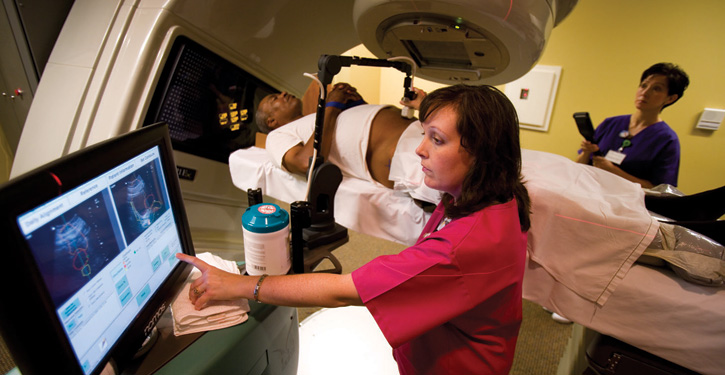Radiation Therapy
The goal of radiation therapy is to get a high enough dose of radiation into the body to kill the cancer cells while sparing the surrounding healthy tissue from damage. Several different radiation therapy techniques have been developed to accomplish this. Depending on the location, size and type of your tumor or tumors, you may receive one or a combination of these techniques. Your radiation oncologist and treatment team will work with you to determine which treatment and how much radiation is best for you.
During external beam radiation therapy, a beam of radiation is directed through the skin to a tumor and the immediate surrounding area in order to destroy the main tumor and any nearby cancer cells. To minimize side effects, the treatments are typically given every day for a number of weeks. The radiation beam comes from a machine located outside of your body that does not touch your skin or the tumor. Receiving external beam radiation is similar to having an X-ray taken. It is a painless, bloodless procedure.
The most common type of machine used to deliver external beam radiation therapy is called a linear accelerator, sometimes called a “linac.” It produces a beam of high-energy X-rays or electrons. Using sophisticated treatment planning software, your radiation oncology treatment team plans the size and shape of the beam, as well as how it is directed at your body, to effectively treat your tumor while sparing the normal tissue surrounding the cancer cells.
 Several special types of radiation therapy are discussed below. These are used for particular types of cancer, and your radiation oncologist will recommend one of these treatments if he or she believes it will help you.
Several special types of radiation therapy are discussed below. These are used for particular types of cancer, and your radiation oncologist will recommend one of these treatments if he or she believes it will help you.
- Image Guided Radiation Therapy (IGRT): The use of various imaging technologies located on the treatment machine (known as on-board imaging), including x-rays and CT scans, to precisely localize the tumor being treated. This results in more accurate, less toxic treatment, especially for tumors located near sensitive structures.
- Intensity Modulated Radiation Therapy (IMRT): An advanced treatment technology using multiple small beams which change shape during treatment. This allows the treated area to conform more accurately to the shape of the tumor, resulting in more intense radiation of the tumor while giving less radiation to surrounding normal tissues.
- Stereotactic Radiotherapy: The use of numerous precisely focused radiation beams combined with advanced imaging technology to deliver highly localized radiation with millimeter accuracy. This technique is most commonly used to treat small tumors in the brain and lung. Related terms include stereotactic radiosurgery (for tumors located in the brain) and stereotactic body radiotherapy (for tumors located in other parts of the body).
- Prostate Seed Implants/Brachytherapy: A procedure where multiple small radioactive seeds are placed into the prostate gland, generally in the operating room under general anesthesia using direct ultrasound guidance. This provides a highly localized dose of radiation to the prostate.

 Learn More
Learn More